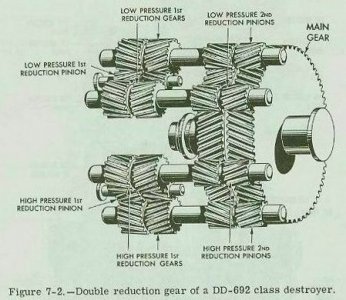Helical gears, as John said, can generate very large thrust loads depending on helix angle and torque applied. The beauty of helical gears is that there are multiple teeth carrying the load at once. This tends to quiet the gear noise as there’s less shock in load transfer. In extreme load cases such as Naval reduction gear sets for steam turbines. they use double helical gears with opposing helix angles to eliminate thrust and to further share the load with additional teeth. Very expensive gears. In actuality the teeth are much finer than the cartoon below.
View attachment 478952
Links to a newer version of my college machine design text and a very good short pdf from NASA below if you want to dig into the theory.


